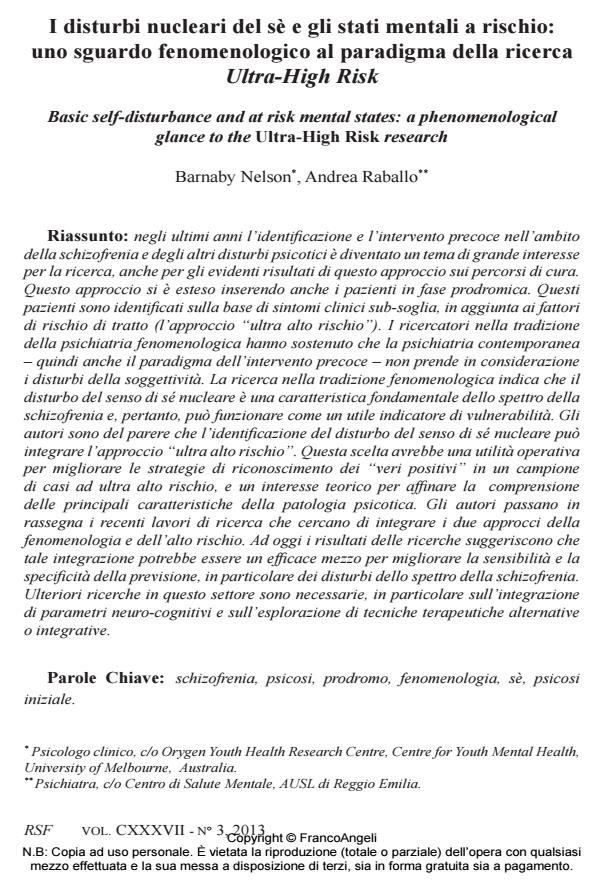I disturbi nucleari del sè e gli stati mentali a rischio: uno sguardo fenomenologico al paradigma della ricerca Ultra-High Risk
Titolo Rivista RIVISTA SPERIMENTALE DI FRENIATRIA
Autori/Curatori Barnaby Nelson, Andrea Raballo
Anno di pubblicazione 2013 Fascicolo 2013/3
Lingua Italiano Numero pagine 33 P. 97-129 Dimensione file 440 KB
DOI 10.3280/RSF2013-003006
Il DOI è il codice a barre della proprietà intellettuale: per saperne di più
clicca qui
Qui sotto puoi vedere in anteprima la prima pagina di questo articolo.
Se questo articolo ti interessa, lo puoi acquistare (e scaricare in formato pdf) seguendo le facili indicazioni per acquistare il download credit. Acquista Download Credits per scaricare questo Articolo in formato PDF

FrancoAngeli è membro della Publishers International Linking Association, Inc (PILA)associazione indipendente e non profit per facilitare (attraverso i servizi tecnologici implementati da CrossRef.org) l’accesso degli studiosi ai contenuti digitali nelle pubblicazioni professionali e scientifiche
Negli ultimi anni l’identificazione e l’intervento precoce nell’ambito della schizofrenia e degli altri disturbi psicotici è diventato un tema di grande interesse per la ricerca, anche per gli evidenti risultati di questo approccio sui percorsi di cura. Questo approccio si è esteso inserendo anche i pazienti in fase prodromica. Questi pazienti sono identificati sulla base di sintomi clinici sub-soglia, in aggiunta ai fattori di rischio di tratto (l’approccio "ultra alto rischio"). I ricercatori nella tradizione della psichiatria fenomenologica hanno sostenuto che la psichiatria contemporanea - quindi anche il paradigma dell’intervento precoce - non prende in considerazione i disturbi della soggettività. La ricerca nella tradizione fenomenologica indica che il disturbo del senso di sé nucleare è una caratteristica fondamentale dello spettro della schizofrenia e, pertanto, può funzionare come un utile indicatore di vulnerabilità. Gli autori sono del parere che l’identificazione del disturbo del senso di sé nucleare può integrare l’approccio "ultra alto rischio". Questa scelta avrebbe una utilità operativa per migliorare le strategie di riconoscimento dei "veri positiv"” in un campione di casi ad ultra alto rischio, e un interesse teorico per affinare la comprensione delle principali caratteristiche della patologia psicotica. Gli autori passano in rassegna i recenti lavori di ricerca che cercano di integrare i due approcci della fenomenologia e dell’alto rischio. Ad oggi i risultati delle ricerche suggeriscono che tale integrazione potrebbe essere un efficace mezzo per migliorare la sensibilità e la specificità della previsione, in particolare dei disturbi dello spettro della schizofrenia. Ulteriori ricerche in questo settore sono necessarie, in particolare sull’integrazione di parametri neuro-cognitivi e sull’esplorazione di tecniche terapeutiche alternative o integrative.
Parole chiave:Schizofrenia, psicosi, prodromo, fenomenologia, sé, psicosi iniziale.
- Early Intervention Services for youth at Clinical High-Risk for Psychosis: The Reggio Emilia At-Risk Mental State (ReARMS) experience Michele Poletti, in RIVISTA SPERIMENTALE DI FRENIATRIA 3/2022 pp.61
DOI: 10.3280/RSF2022-003004 - Esordi psicotici in adolescenza e giovane età adulta: prospettive teoriche e di trattamento Federica Paterlini, in RIVISTA SPERIMENTALE DI FRENIATRIA 3/2022 pp.31
DOI: 10.3280/RSF2022-003003
Barnaby Nelson, Andrea Raballo, I disturbi nucleari del sè e gli stati mentali a rischio: uno sguardo fenomenologico al paradigma della ricerca Ultra-High Risk in "RIVISTA SPERIMENTALE DI FRENIATRIA" 3/2013, pp 97-129, DOI: 10.3280/RSF2013-003006